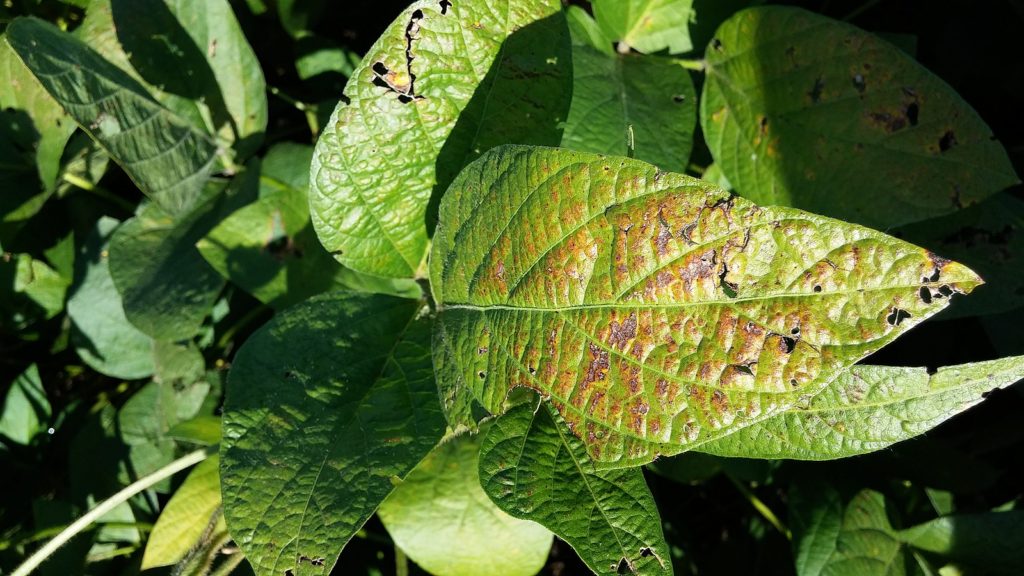Environmental Conditions in Soybean Diseases
go.ncsu.edu/readext?714270
en Español / em Português
El inglés es el idioma de control de esta página. En la medida en que haya algún conflicto entre la traducción al inglés y la traducción, el inglés prevalece.
Al hacer clic en el enlace de traducción se activa un servicio de traducción gratuito para convertir la página al español. Al igual que con cualquier traducción por Internet, la conversión no es sensible al contexto y puede que no traduzca el texto en su significado original. NC State Extension no garantiza la exactitud del texto traducido. Por favor, tenga en cuenta que algunas aplicaciones y/o servicios pueden no funcionar como se espera cuando se traducen.
Português
Inglês é o idioma de controle desta página. Na medida que haja algum conflito entre o texto original em Inglês e a tradução, o Inglês prevalece.
Ao clicar no link de tradução, um serviço gratuito de tradução será ativado para converter a página para o Português. Como em qualquer tradução pela internet, a conversão não é sensivel ao contexto e pode não ocorrer a tradução para o significado orginal. O serviço de Extensão da Carolina do Norte (NC State Extension) não garante a exatidão do texto traduzido. Por favor, observe que algumas funções ou serviços podem não funcionar como esperado após a tradução.
English
English is the controlling language of this page. To the extent there is any conflict between the English text and the translation, English controls.
Clicking on the translation link activates a free translation service to convert the page to Spanish. As with any Internet translation, the conversion is not context-sensitive and may not translate the text to its original meaning. NC State Extension does not guarantee the accuracy of the translated text. Please note that some applications and/or services may not function as expected when translated.
Collapse ▲Today I would like to talk to you about a continuing conducive environment for diseases in soybeans and prevalent soybean seedling diseases. Early planting conditions were cool and wet and this has led to numerous reports of stands lost to dampening off pathogens.
Farmers have not yet planted soybeans should be mindful of the impacts of seedling diseases. Current conditions are warm and extremely wet and a lot of the regions of our County and these conditions favor pathogens like pythium, Phytophthora, and Rhizoctonia as well as fusarium. There are several options for reducing seedling disease which may include the use of seed treatments.
Choosing a chemical management strategies reliant on a good diagnosis and to make sure that the seed treatment includes active ingredients that are effective on the prevalent pathogen populations. For an accurate diagnosis of seedling disease pathogens please contact your local County agent here at the Union County Ag Center. Now disease considerations moving forward and as the growing season continues to be challenging with continued rainy conditions in most of the state or weather continues to be warmer and with these excessive wet conditions, we may be faced with several foliar diseases that could be yield-limiting.
Cercospora, frog eyed leaf spot, and Target spot maybe potentially yield-limiting if plants are affected between growth stages R3 and R5. Fungicides may be needed for susceptible varieties during that period of time. The further potential concern is soybean rust in late-planted soybean should weather patterns favor its movement and development. Currently, the closest report of soybean rust is in Hampton County, South Carolina. When a report of soybean rust is within a hundred miles of North Carolina soybean production announcements will be made to the NC State soybean portal and through the N.C. Cooperative Extension of Union County website. So scouting for foliar diseases especially during R3 and R5 growth stages may be particularly important this year to make foliar disease management decisions.
Root rot diseases like those caused by Fusarium and phytophthora may also be more severe given extended periods of saturated conditions. Make sure you scout regularly especially in areas with low lying fields in areas with high yield potential. Fungicides may be necessary as part of the disease management program this year due to weather conditions. Fungicide efficiency and efficacy are re-evaluated each year across the state and a joint fungicide efficacy table has been generated through the crop protection network. Again regular scouting will help to determine fungicide needs. So for more information on diseases of soybeans, there are several resources available is always don’t hesitate to contact your local Extension agent for any assistance.





